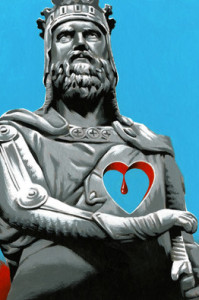WSJ Historically Speaking: Burying the Body in One Place and the Heart in Another
Halloween is an eloquent denial of the finality of death. Throughout history, people have resisted the idea that life begins and ends with the human body. Even the most ghoulish Halloween story starts with the premise that life exists in more than one realm.
During the medieval period, the belief that the physical and spiritual worlds were intertwined fed into the idea that the soul was located inside the heart. Many aristocrats and royals even had their hearts removed after death. Their corpses were then interred in the family crypt, while the heart was preserved and buried in a place of spiritual significance.
That usually meant a favorite monastery. But for Richard I, known as “The Lionheart” (he supposedly once ate the heart of a lion), it meant having his body buried in England and his heart in France—a way to demonstrate his divine right to wear the crowns of both kingdoms.
Jerusalem was another popular destination. This was where Robert the Bruce (1274-1329), king of the Scots, begged his fellow knights to bury his heart. A band of Celtic crusaders duly set off, bearing the organ inside a silver casket. They got as far as Spain, where most of them were killed fighting the Moors. The heart was rescued by one of the survivors and carried back to Scotland. It was subsequently lost until the 20th century, when archaeologists accidentally stumbled upon the casket while making an inventory of Melrose Abbey in Roxburghshire, Scotland. The heart was left in situ, denying Robert his wish.
British monarchs continued to have their hearts preserved long after the tradition fell out of favor elsewhere in Europe. George II(1683-1760) was the last British king to have two burials: His body received one funeral and his heart another, after being conveyed to Westminster Abbey in its own coach, solemnly accompanied by the entire royal household.
After George’s death, some 19th-century romantic poets kept the practice alive. In 1822, as the corpse of Percy Bysshe Shelley was being cremated in Viareggio, Italy, the novelistEdward Trelawny rescued the poet’s heart. For reasons of his own, Trelawny then handed his friend’s heart to the poet Leigh Hunt, who refused Mary Shelley’s entreaties to return it until he was forced to do so by Lord Byron. Two years later, when Byron died during the Greek War of Independence, Trelawny saw to it that Byron’s body made the journey home while the heart remained in Greece.
In 1832, the philosopher Jeremy Bentham made fun of the practice by requesting to have not just his heart but his entire body preserved, dressed and placed inside a glass case. The idea was to have it wheeled out whenever his friends met for conversation. The macabre display, known as the Auto-Icon, eventually ended up with University College London—in the college’s words, Bentham’s “preserved skeleton, dressed in his own clothes, and surmounted by a wax head.” In 1975, students from rival King’s College London kidnapped Bentham’s actual head, which the college also used to display, and held it for a ransom of £100 for a charity. The Auto-Icon’s glass case is now tightly secured, and the real head is kept in a safe.
The spiritual symbolism of hearts has diminished since Bentham’s day. Nevertheless, a row between Thomas Hardy’s friends and family resulted in the novelist’s ashes being interred in 1928 at Westminster Abbey and his heart at Stinsford Church, Dorset. It has been claimed—though never proven—that Hardy’s sister left the heart on the kitchen table, where it was partially eaten by the family cat. The offending feline was subsequently killed and buried alongside what remained of its dinner.

